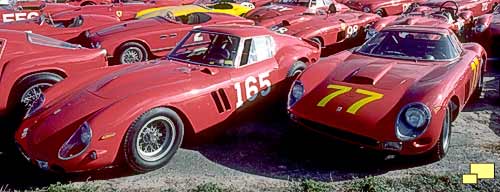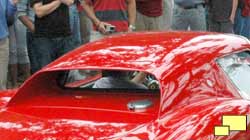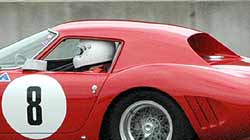
Interior
Engine/Transmission
GTO Up Close
Racing GTO
1984 GTO
GTO Exposed
GTO Specifications
Car and Driver
Comparison
GTO Trivia
Pontiac GTO
GTO Books
by Charles Maher

Click Here
to purchase from CarArtInc.com
|
|
||||||
|
||||||
32 of the 250 series GTOs, with a series 1 body style similar to number 165 above, were built in 1962 and 1963. Three others, such as number 77 above (s/n 5575), were equipped with the 1964 series 2 body style. A number of the early cars, (s/n 3413 GT, 4091 GT, 4399 GT and 4675 GT) were rebodied with the later body style. Within a body style there were often variations, including the location of the fuel filler, radiator openings, tail lights, brake cooling ducts and so on. Three more were made with larger 4.0 liter engines and are known as "330 GTOs" and one was built with an LMB body. All were built by Scaglietti out of 21 gauge aluminum. Ferrari practice at the time was to label a model with a number corresponding to the cubic centimeter displacement of a single cylinder. Since the GTOs were V12s, multiplying the cylinder displacement by 12 would reveal the displacement. In the case of a 250 GTO, 12 X 250 = 3,000, or 3.0 liters. 31 of the cars were left hand drive, nine were right hand drive. 23 came from the factory painted "Rosso Cina" (China Red).
|
||||||

|
||||||
| Above: Number 37, (s/n 4091 GT) an example of a series 2 car and number 10 (s/n 3729 GT), a series 1 GTO as seen from the back, where the differences are pronounced. The series 1 cars had an aerodynamic advantage. Two of the series 2 cars ( s/n 4675 GT below left and s/n 3413 GT, right) retained the aerodynamic advantage with a long roof design. | ||||||
|
||||||
|
|
||||||
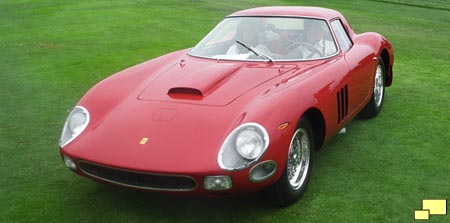
|
||||||
| Above: s/n 5575 GT, the last Ferrari 250 GTO made. Although most fans of the Ferrari GTO favor the "traditional" series 1 body style, the series 2 was admired for being a solid 10 years ahead of its time. Note the cold air induction port on the hood, added to provide an advantage on the faster race tracks. Below: A full view of s/n 4675, which is actually an early 1962 car rebodied by Scaglietti. Although the series 1 bodies varied considerably, the series 2 cars (with the exception of the long/short roof configurations) were comparatively consistent. | ||||||
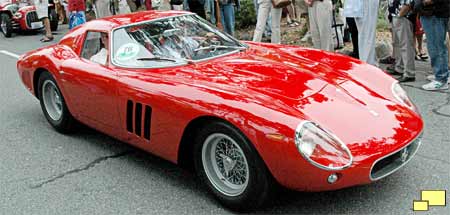
|
||||||
|
|
||||||
Ferrari GTO, Part III |
|
Note: Clicking on an image with this symbol ( (A new window will open in your browser) |
||

Suggestions? Comments? Tell us!!! |

|
|
